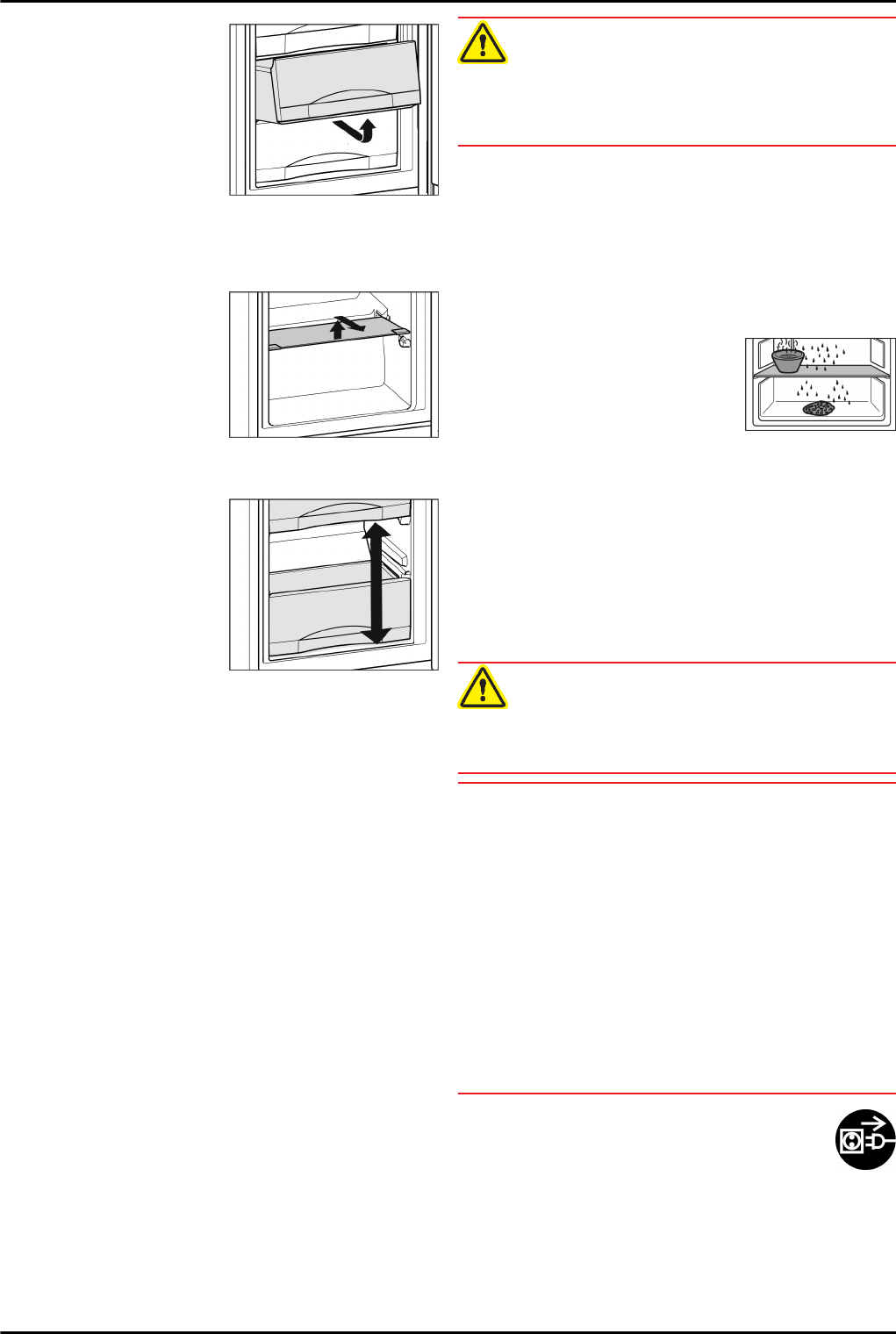
u
To store frozen food directly on the shelves: pull the drawer
forwards and lift it out.
5.5.6 Shelves
u
To remove the shelf: lift up
at the front and pull out.
u
To put the shelf back: simply
push in as far as it will go.
5.5.7 VarioSpace
Apart from being able to
remove the drawers, you can
also remove the shelves,
creating space for large items
of frozen food. Poultry, meat,
large pieces of game and high
bakery products can be frozen
in one piece and prepared.
u
The maximum load of frozen
food for the drawers is 25 kg
each and for the shelves
35 kg each.
6 Maintenance
6.1 Defrosting with NoFrost*
The NoFrost system automatically defrosts the appliance.
Refrigerator compartment:
The defrost water evaporates due to the compressor heat.
Drops of water on the rear wall are perfectly normal.
u
Regularly clean the drain opening to allow the water to flow
away (see 6.3) .
Freezer compartment:
The moisture condenses on the evaporator, is periodically
defrosted and evaporates.
u
The appliance does not have to be manually defrosted.
6.2 Manual defrosting*
The refrigerator compartment is defrosted automatically.
The defrost water evaporates as a result of the heat of the
compressor. Drops of water on the rear wall are perfectly
normal.
u
Regularly clean the drain opening to allow the water to flow
away (see 6.3) .
A layer of frost or ice can build up in the freezer compartment
after a long period of operation.
The layer of frost or ice builds up faster if the appliance is
opened often or if the food is warm when placed inside.
However, a thick layer of ice will increase the appliance‘s
energy consumption. You should therefore defrost the appli-
ance regularly.
CAUTION
Risk of injury and damage as a result of hot steam!
u
Do not use electric heaters or steam cleaners, naked flames
or defrosting sprays for defrosting.
u
Do not remove ice using sharp instruments.
u
Switch on SuperFrost one day before defrosting.
w
The frozen goods are provided with a “cold reserve”.
u
Switch off the appliance.
w
The temperature display goes out.
w
If the temperature display does not go out, the child lock
function (see 5.1) is active.
u
Pull out the power plug or switch off the fuse.
u
If possible, put the frozen goods in the freezer drawer,
wrapped in newspaper or a blanket, and store in a cool
place.
u
Place a pan with hot, not boiling
water on a middle shelf.
-or-
u
Half-fill the two lower drawers with
lukewarm water and put them in the
appliance.
w
Defrosting is speeded up.
w
Defrost water is collected in the drawers.
u
Leave the door of the appliance open while defrosting.
u
Remove detached pieces of ice.
u
Pay attention that the defrost water does not run into the
kitchen unit.
u
If necessary, pick up defrost water several times, using a
sponge or cloth.
u
Clean the appliance (see 6.3) and rub dry.
6.3 Cleaning the appliance
WARNING
Risk of injury and damage as a result of hot steam!
Hot steam can lead to burns and can damage the surfaces.
u
Do not use any steam cleaners!
NOTICE
Incorrect cleaning damages the appliance!
u
Do not use cleaning agents in concentrated form.
u
Do not use any scouring or abrasive sponges or steel wool.
u
Please do not use any aggressive, scouring, sand-,
chloride-, chemical- or acid-based cleaning agents.
u
Do not use chemical solvents.
u
Do not damage or remove the type plate on the inside of the
appliance. It is important for the customer service.
u
Do not pull off, bend or damage cables or other compo-
nents.
u
Do not allow any cleaning water to enter the drain channel,
ventilation grille or electrical parts.
u
Please use soft cleaning cloths and a universal pH-neutral
cleaning agent.
u
Please use cleaning and care products suitable for contact
with foodstuffs in the appliance interior.
u
Empty appliance.
u
Pull out the power plug.
u
Clean plastic outer and inner surfaces with lukewarm
water and a little washing-up liquid.
Maintenance
8 * Depending on model and options














